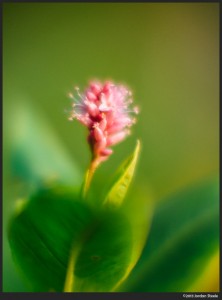Image Quality: Sharpness
For such a fast lens, the Voigtländer 42.5mm f/0.95 is quite sharp, even at wide apertures. At typical portrait focus distances, the 42.5mm f/0.95 is quite sharp right from f/0.95, though there is lowered contrast than at smaller apertures. However, focusing outside of this range, both on more distant subjects and especially on closer subjects, results in softer images when the lens is shot wide open, predominantly due to rather heavy spherical aberration at certain focus distances. I’ll get into that more in a little while.
At f/0.95 to f/1.4, the lens provides enough sharpness to give you nice detail at the point of focus, while falling off gracefully to allow for very nice portraits.
Once stopped down to f/1.4 or f/2., the lens loses most of its low-contrast glow and starts becoming extremely sharp. At f/4-f/8, the lens is razor sharp from corner to corner. Click on the image below to enlarge.

Image Quality: Bokeh

With a lens of this speed and focal length, a primary use for this lens will be for creating shallow depth of field images and blurring backgrounds, so the quality of the bokeh is of major importance for a lens such as this. The 42.5mm f/0.95, like many Voigtländer lenses, has a very unique bokeh signature. At f/0.95, the specular highlights take on a cat’s eye appearance, and at closer focus distance create a beautifully soft swirly look to the blurred background. I personally find this look to be utterly gorgeous for portraits, though it is a very subjective thing. At closer portrait distances, the specular highlights are soft and even and the light glow and falloff make for a very unique rendering that is quite different from the more crisp and ‘perfect’ look you get from the more corrected fast Micro 4/3 primes such as the Olympus 75mm f/1.8. This quality is very evident on the image to the right.
However, if you are using the lens to shoot more distant subjects and still provide isolation, the look becomes much harsher, in addition to amplifying many of the aberrations of the lens at wide apertures. At further focus distances, the specular highlights gain a bright green ring that is very prominent, and the overall rendering of the background becomes quite busy. Some people love harsher unique bokeh such as this, though I don’t personally care for it that much. This is very evident on the image below.

When the lens is stopped down, highlights remain relatively rounded, though the shape of the 10 aperture blades is visible, as they are not curved diaphragm blades. However, bokeh remains of a similar quality to the wide open rendering, though the ‘swirl’ nature of the bokeh is lost at smaller apertures.
Image Quality: Lens Aberrations and Flare

The weak points of the Voigtländer 42.5mm f/0.95 is in chromatic aberration and spherical aberration. While the Nokton controls lateral chromatic aberration quite well, the lens is very prone to purple fringing and longitudinal chromatic aberration at wider apertures, which improves a bit at smaller apertures. At typical portrait distances and lighting, the chromatic aberrations don’t seem to be too much of a problem, but further out they appear to multiply, which is a little bit of an odd behavior.
At wider apertures, the lens exhibits rather significant spherical aberration, which appears as a low contrast glow. The lens is optimized for the 1-3m range which is typical for portrait shooting, and at these points wide open, spherical aberration is present, but not overly intrusive. Proper postprocessing can eliminate any real visible remains of the glow. However, the lens worsens in this regard on more distant subjects and especially on much closer subjects. At f/0.95 near minimum focus distance, there is a very pronounced glow filling the whole image and resolution is dramatically reduced as a result. When shooting near minimum focus distance, it is advisable to stop down to at least f/2 if your goal is to obtain sharp focus on your subject. However, the extreme close focusing ability combined with the dreamy look the spherical aberration and extremely shallow depth of field creates is quite beautiful in its own right, and can make for some very unique closeups such as the flower on the left.
The good news is that spherical aberration is essentially fully corrected by f/1.4 at most focus distances and by f/2 when focusing extremely close.
The lens is prone to rather complex flare when shooting directly into the sun, but resists veiling flare relatively well with minimal loss of contrast in those situations. Overall an OK performance, but nothing to write home about.
Image Quality: Color and Contrast
The character of the color and contrast changes a little throughout the aperture range with the 42.5mm f/0.95. At wider apertures, the lens by default produces low contrast images with somewhat muted color. These can be brought to a much higher contrast look with minimal post-processing and the color information responds well to saturation adjustments. Stopped down, the images become much more crisp with a higher contrast look and richer color profile.
The combination of all these factors results in images from the Nokton 42.5mm f/0.95 having a very unique look to them. The combination of interesting but pretty bokeh, good resolution, and a soft low contrast glow make for a really beautiful look to portraits at wide apertures and a much richer look when stopping down a bit. Some may not like the way the lens renders, but if you’re a fan of how Voigtländer images typically look, you’ll love the shots you get out of the 42.5mm f/0.95.
One more thing:
While I didn’t run into this issue with the 17.5mm f/0.95 Nokton, the 42.5mm f/0.95 seems to be somewhat slower than expected with regards to actual light passage. While the optical properties of the lens show f/0.95 with regards to depth of field and such, exposure was not quite there. The lens exposed wide open much closer to around f/1.1, being around 2/3 stop faster than f/1.4 rather than a full stop. Part of this may be the rather heavy vignetting that is visible at f/0.95, though other losses may be inherent as well.





Leave a Reply